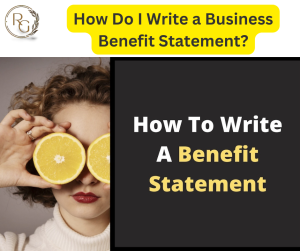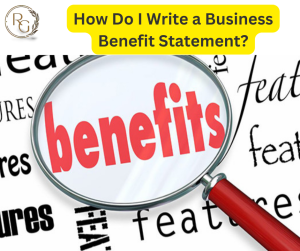How Do I Write a Business Benefit Statement?
When writing a business benefit statement, consider the two types of return – emotional and financial. The emotional return will make your customer feel something, while the financial benefit will save your customer money. In other words, your product must satisfy both needs. A compelling business benefit statement will make a customer feel something, and save them money. This is why the most compelling benefits are those that offer both financial and emotional value.

Intangible vs tangible
The difference between tangible and intangible assets lies in the value they provide. The value of tangible assets can be easily determined, such as the company’s plant and machinery. Intangible assets, on the other hand, may be harder to measure, but they still matter. Companies with intangible assets have a brand name, which can be valued at incalculable amounts and drive the value of earnings. Companies in the healthcare industry often have an intangible component of their business value, such as their valuable employees and research and development of medicines.
While consumers might buy tangible products, they will be disappointed if they don’t receive the results they are expecting. Intangible products, on the other hand, are prone to human discretion and idiosyncrasy. Intangible goods tend to be less reliable than they should be, and are often more expensive. As a result, they tend to be less satisfying to customers. In addition, tangible goods require a consistent delivery of value.
Example
For example, a chemical company realizes the value of intangible benefits. The company’s customers may have a positive perception of the product and need it. But there is no way to quantify the value of intangible products. For example, a chemical company might see intangible benefits and use them in marketing to drive its sales. A company that values intangible benefits may not be able to offer its products without addressing its customers’ concerns.
Another difference between intangible and tangible assets is their value. A tangible asset, by definition, can be worth whatever the market will bear. For example, a new car may be worth the exact same amount, but it will eventually depreciate in value. Similarly, a software company may make software or other electronic products that are valuable to its customers. But an intangible asset, by contrast, cannot be measured in terms of its value, which may fluctuate constantly.
Difference
The difference between tangible and intangible business benefits is often best illustrated by the way a company sells its goods. Intangible products cannot be tested in advance, so potential buyers must rely on surrogates to judge the quality of the product. The intangible benefits of a company’s products and services are not readily apparent to the customer until they are used. If a product is sold or delivered incorrectly, a buyer cannot tell how good it is until it is in use.
Cause and effect scenario
If you want to make changes to your business, cause and effect analysis may be the solution you need. This type of analysis combines brainstorming, critical analysis, and visual representation. The result is a more complete picture of your company’s needs. Using this method, you can improve the quality of your products or services, or implement better management practices. In this article, we’ll explore the basics of this analysis.
During a business process, a cause-and-effect diagram is often used. It involves looking both forward and backward to see the effect of various changes. The diagram’s goal is to identify problems and opportunities, as well as mistakes and money lost, and to highlight positive outcomes. If a change is needed, a cause-and-effect diagram will tell you what you need to do.
Once you’ve mapped out the effects of a change, you can implement a solution.
Another way to use a cause-and-effect diagram is to analyze problems and propose solutions. By creating a cause-and-effect scenario, you’ll be able to identify issues within a business and make the necessary changes to avoid future issues. The cause and effect diagram is also called a fishbone diagram, and it can be used in almost any type of business setting. So, what are the benefits and costs of a change?
A cause-and-effect diagram can be created alone, but it’s more effective to collaborate with other people. When you collaborate with multiple people, you’ll gain insights that would otherwise be unavailable. If you’re a business consultant, create a cause-and-effect diagram that shows the results of the change. A proper cause-and-effect diagram should have multiple bones, as well as many lines. This method is called the “Five-Whys” technique.

Creating trust with your business benefit statement
Creating trust with your business benefit statement can make all the difference. The most important thing to remember is to listen to stakeholders and pick the areas in which you want to lead. This way, you will be able to establish a foundation for trust in your organization. Creating trust starts with the basics, and you can build on it from there. You can get recommendations from trusted sources, and it is important to get the right advice for your specific needs.
First step of Business Benefit Statement
The first step in creating trust is to make your benefit statement as short as possible. People tend to tune out long benefit statements, so keep them short and sweet. Instead of giving away a ton of information in a sentence or two, focus on one key benefit that will make customers want to explore your site further. This statement can also be used to double as your homepage headline if you’d prefer to use that.
Creating trust with your business benefit statement involves educating stakeholders on what you offer and why they should trust you. This goes for employees, people, processes, software, and more. Chances are, your product or service has a lot of benefits. The next step is to identify the specific benefits from the perspective of your target audience. Many marketing experts create benefit statements based on marketing idealism. They focus on justifying their differences and ignore what their clients actually value.
When it comes to implementing trust-building strategies, fewer than half of business leaders have implemented these strategies. The smaller percentages have implemented trust-steering committees and proactive crisis communications plans. Developing employee trust is critical for growth and retention. It’s also essential for reducing turnover. And remember, building employee trust can be a big part of building social equity and economic progress. So, take the time to create trust in your company. It’s well worth it.
Read This for Business


Your article made me suddenly realize that I am writing a thesis on gate.io. After reading your article, I have a different way of thinking, thank you. However, I still have some doubts, can you help me? Thanks.
I may need your help. I tried many ways but couldn’t solve it, but after reading your article, I think you have a way to help me. I’m looking forward for your reply. Thanks.